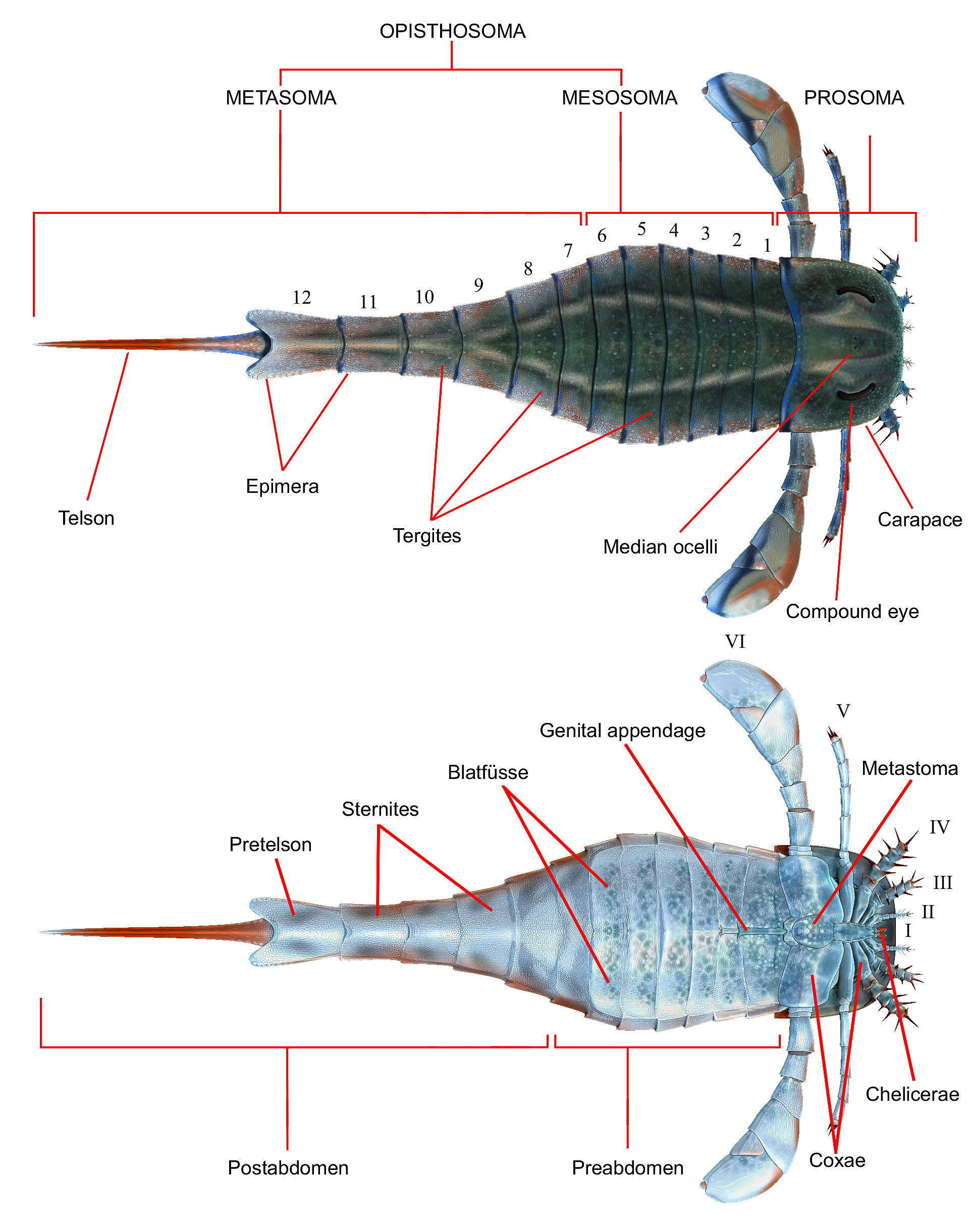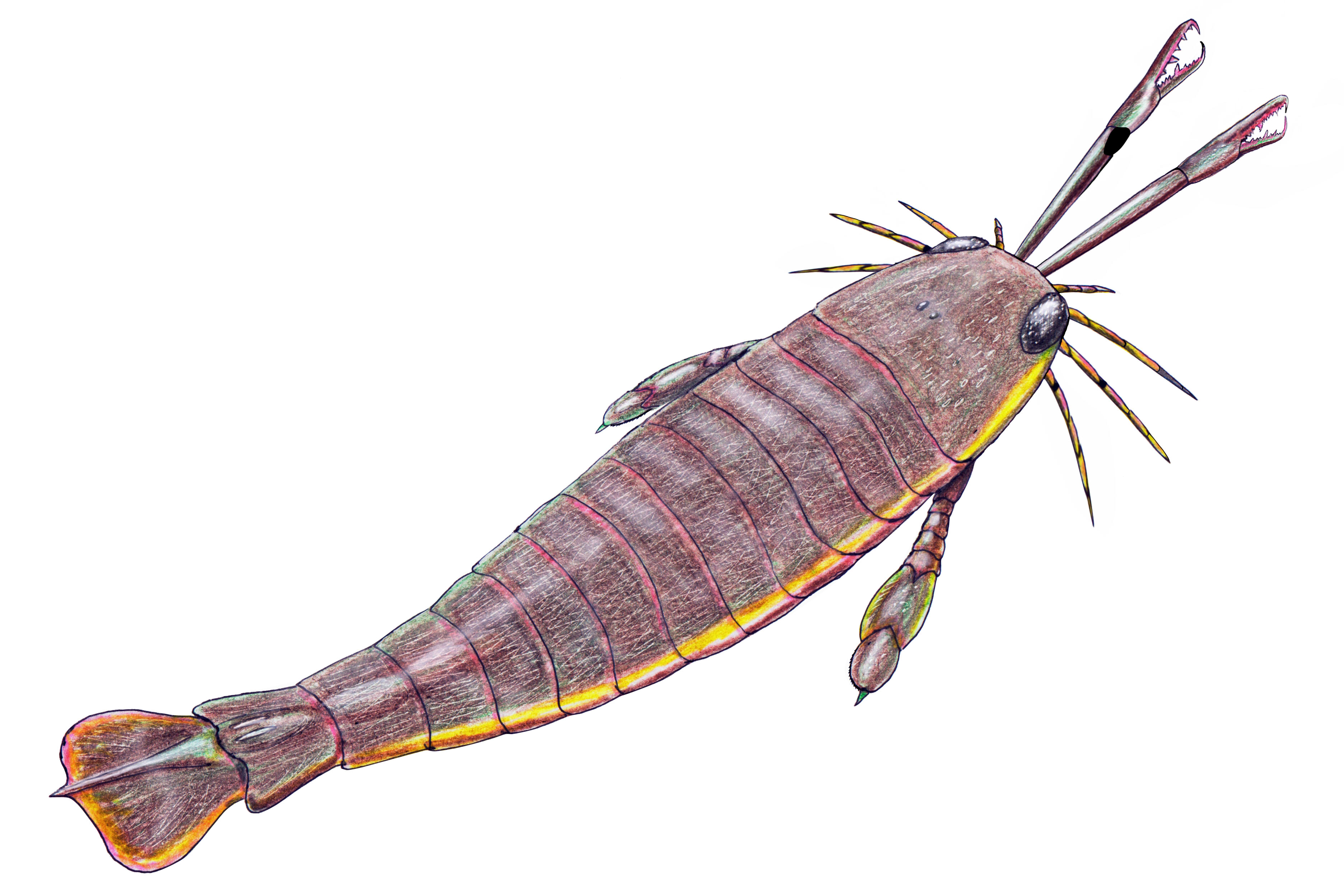|
Carcinosoma
''Carcinosoma'' (meaning "crab body") is a genus of eurypterid, an extinct group of aquatic arthropods. Fossils of ''Carcinosoma'' are restricted to deposits of late Silurian (Late Llandovery to Early Pridoli) age. Classified as part of the family Carcinosomatidae, which the genus lends its name to, ''Carcinosoma'' contains seven species from North America and Great Britain. Carcinosomatid eurypterids had unusual proportions and features compared to other eurypterids, with a broad abdomen, thin and long tail and spined and forward-facing walking appendages. They were not as streamlined as other groups but had considerably more robust and well developed walking appendages. In ''Carcinosoma'', these spined walking appendages are thought to have been used to create a trap to capture prey in. The telson (the posteriormost division of the body) of ''Carcinosoma'' appears to have possessed distinct segmentation, ''Carcinosoma'' is the only known eurypterid to possess this feature. At ... [...More Info...] [...Related Items...] OR: [Wikipedia] [Google] [Baidu] |
Carcinosomatidae
Carcinosomatidae (the name deriving from the type genus ''Carcinosoma'', meaning "crab body")Meaning osomaat ''www.dictionary.com''. Retrieved 7 September 2018. is a family of Eurypterid, eurypterids, an extinct group of aquatic Arthropod, arthropods. They were members of the superfamily Carcinosomatoidea, also named after ''Carcinosoma''. Fossils of carcinosomatids have been found in North America, Europe and Asia, the family possibly having achieved a worldwide distribution, and range in age from the Late Ordovician to the Early Devonian. They were among the most marine eurypterids, known almost entirely from marine environments. Carcinosomatids varied considerably in size, from species only a few centimetres in length to some of the largest known arthropods. The largest carcinosomatid species, ''Carcinosoma punctatum'', reached lengths of at least and rivalled the largest eurypterid of all, ''Jaekelopterus'', in size. Morphologically, carcinosomatids were highly distinct from ... [...More Info...] [...Related Items...] OR: [Wikipedia] [Google] [Baidu] |
Eusarcana
''Eusarcana'' (meaning "true flesh") is a genus of eurypterid, an extinct group of aquatic arthropods. Fossils of ''Eusarcana'' have been discovered in deposits ranging in age from the Early Silurian to the Early Devonian. Classified as part of the family Carcinosomatidae, the genus contains three species, ''E. acrocephalus'', ''E. obesus'' and ''E. scorpionis'', from the Silurian-Devonian of Scotland, the Czech Republic and the United States respectively. ''Eusarcana'' is known for its odd proportions and features; the broad abdomen, thin and long tail, spined and forward-facing walking appendages and sharp and curved tail spike differentiate it from most other eurypterids, but are shared with other carcinosomatid eurypterids. The triangular carapace, oddly positioned forward-facing eyes differentiate the genus further from its closest relatives. At 80 centimetres (31.5 in) in length, ''E. scorpionis'' represents a moderately large species of eurypterid, and far exceeded ... [...More Info...] [...Related Items...] OR: [Wikipedia] [Google] [Baidu] |
Megalograptus
''Megalograptus'' is a genus of eurypterid, an extinct group of aquatic arthropods. Fossils of ''Megalograptus'' have been recovered in deposits of Katian ( Late Ordovician) age in North America. The genus contains five species: ''M. alveolatus'', ''M. ohioensis'', ''M. shideleri'', ''M. welchi'' and ''M. williamsae'', all based on fossil material found in the United States. Fossils unassigned to any particular species have also been found in Canada. The generic name translates to "great writing" and originates from the mistaken original belief that ''Megalograptus'' was a type of graptolite, often given names ending with -''graptus'' (meaning 'writing'). ''Megalograptus'' was a large predatory megalograptid eurypterid, with the largest and best known species, ''M. ohioensis'', reaching body lengths of . Some species were substantially smaller, with the smallest, belonging to a hitherto undetermined species, only growing to about in length. Morphologically, ''Megalograptus' ... [...More Info...] [...Related Items...] OR: [Wikipedia] [Google] [Baidu] |
Eurypterids
Eurypterids, often informally called sea scorpions, are a group of extinct arthropods that form the order Eurypterida. The earliest known eurypterids date to the Darriwilian stage of the Ordovician period 467.3 million years ago. The group is likely to have appeared first either during the Early Ordovician or Late Cambrian period. With approximately 250 species, the Eurypterida is the most diverse Paleozoic chelicerate order. Following their appearance during the Ordovician, eurypterids became major components of marine faunas during the Silurian, from which the majority of eurypterid species have been described. The Silurian genus ''Eurypterus'' accounts for more than 90% of all known eurypterid specimens. Though the group continued to diversify during the subsequent Devonian period, the eurypterids were heavily affected by the Late Devonian extinction event. They declined in numbers and diversity until becoming extinct during the Permian–Triassic extinction event (or sometim ... [...More Info...] [...Related Items...] OR: [Wikipedia] [Google] [Baidu] |
Eurypterid
Eurypterids, often informally called sea scorpions, are a group of extinct arthropods that form the order Eurypterida. The earliest known eurypterids date to the Darriwilian stage of the Ordovician period 467.3 million years ago. The group is likely to have appeared first either during the Early Ordovician or Late Cambrian period. With approximately 250 species, the Eurypterida is the most diverse Paleozoic chelicerate order. Following their appearance during the Ordovician, eurypterids became major components of marine faunas during the Silurian, from which the majority of eurypterid species have been described. The Silurian genus ''Eurypterus'' accounts for more than 90% of all known eurypterid specimens. Though the group continued to diversify during the subsequent Devonian period, the eurypterids were heavily affected by the Late Devonian extinction event. They declined in numbers and diversity until becoming extinct during the Permian–Triassic extinction event (or sometim ... [...More Info...] [...Related Items...] OR: [Wikipedia] [Google] [Baidu] |
Carcinosomatoidea
Carcinosomatoidea is an extinct superfamily of eurypterids, an extinct group of chelicerate arthropods commonly known as "sea scorpions". It is one of the superfamilies classified as part of the suborder Eurypterina. Some carcinosomatoid genera have been suggested to have been fully marine as opposed to living in near-shore brackish or hypersaline environments. The majority of carcinosomatoid taxa are known from the paleocontinents of Laurentia, Baltica and Avalonia. Isolated and fragmentary fossils from the Late Silurian of Vietnam and the Czech Republic show that the terranes of Annamia and Perunica were within the geographical range of the carcinosomatoids. Only a few basal carcinosomatoids (e.g. '' Carcinosoma'' and ''Paracarcinosoma'') have been found in deeper waters whilst the more derived forms, such as ''Mixopterus'' and ''Lanarkopterus'' have not. Basal carcinosomatoids (Carcinosomatidae) are likely responsible for the fossil remains in Vietnam and the Czech Republic ... [...More Info...] [...Related Items...] OR: [Wikipedia] [Google] [Baidu] |
Kokomo Formation
The Kokomo Formation is a geologic formation in Indiana. It preserves fossils dating back to the Silurian period, most notably sea scorpions. List of Known Taxa Eurypterids * ''Carcinosoma newlini'' * ''Kokomopterus longicaudatus''''Morphology, Taxonomy, and Classification of the Order Eurypterida Burmeister, 1843 V. P. Tollerton, Jr. Journal of Paleontology Vol. 63, No. 5 (Sep., 1989), pp. 642-657'' * ''Erieopterus limuloides''''Dunlop, J. A., Penney, D. & Jekel, D. 2015. A summary list of fossil spiders and their relatives. In World Spider Catalog. Natural History Museum Bern, online at http://wsc.nmbe.ch, version 16.0 http://www.wsc.nmbe.ch/resources/fossils/Fossils16.0.pdf (PDF).'' * ''Erieopterus ranilarva'' * ''Onychopterella kokomensis'''''' * ''Leperditia ohioensis'' Brachiopods * ''Lingula Lingula is Latin for "little tongue". It can stand for: * ''Lingula'' (brachiopod), a brachiopod genus of the family Lingulidae, which is among the few brachiopods survi ... [...More Info...] [...Related Items...] OR: [Wikipedia] [Google] [Baidu] |
Pterygotidae
Pterygotidae (the name deriving from the type genus '' Pterygotus'', meaning "winged one") is a family of eurypterids, an extinct group of aquatic arthropods. They were members of the superfamily Pterygotioidea. Pterygotids were the largest known arthropods to have ever lived with some members of the family, such as '' Jaekelopterus'' and '' Acutiramus'', exceeding 2 metres (6.6 ft) in length. Their fossilized remains have been recovered in deposits ranging in age from 428 to 372 million years old ( Late Silurian to Late Devonian). One of the most successful groups of eurypterids, the pterygotids were the only eurypterid family to achieve a truly worldwide distribution. Several evolutionary innovations made the pterygotids unique among the eurypterids, with large and flattened telsons (the posteriormost division of the body) likely used as rudders to provide additional agility and enlarged chelicerae (frontal appendages) with claws. These claws were robust and possessed ... [...More Info...] [...Related Items...] OR: [Wikipedia] [Google] [Baidu] |
Metasoma
The metasoma is the posterior part of the body, or tagma, of arthropods whose body is composed of three parts, the other two being the prosoma and the mesosoma. In insects, it contains most of the digestive tract, respiratory system, and circulatory system, and the apical segments are typically modified to form genitalia. In a few of the most primitive insects (the Archaeognatha), the metasomal segments bear small, articulated appendages called "styli", which are often considered to be vestigial. There are also pre-apical appendages in most insect orders, called cerci, which may be multi-segmented and almost resembling a posterior pair of antennae; these may be variously modified, or lost entirely. Otherwise, most adult insects lack appendages on the metasoma, though many larval insects (e.g., caterpillars) have some form of appendages, such as prolegs or, in aquatic insects, gills. In apocritan Hymenoptera (wasps, bees and ants), the metasoma consists of the second abdo ... [...More Info...] [...Related Items...] OR: [Wikipedia] [Google] [Baidu] |





